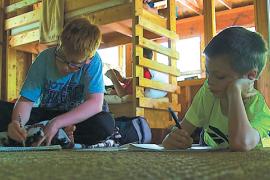Galileo Galilei did not go blind looking at the sun through his telescope, despite the urban legend promulgated by manufacturers of sun filters and even NASA. Instead, his blindness in his early seventies was caused by cataracts and glaucoma (Mulder, 1922). Sitting close to the television for prolonged periods of time also does no harm, despite what your parents may have told you. Television may have some deleterious effects, but none of them is ocular. What happens when you slow down and look at something static — like a painting or a landscape — for several hours is actually quite magical.
According to Harvard professor of humanities Jennifer L. Roberts, deceleration and immersive attention help people detect not only nuances but also obvious aspects of an object or scene that we would otherwise miss. At a recent conference on learning and teaching, Roberts described that although she “makes broad use of digital technology in her teaching, she feels that it is also essential to give students experience in modes of attentive discipline that run directly counter to the high-speed, technologically assisted pedagogies emerging in the digital era — and to the experiences and expectations of contemporary students” (personal communication). In an accelerated world, intellectual lingering pays surprising dividends.
To Taste or to Savor?
One of Robert’s assignments for all of her undergraduate and graduate courses requires each student to pick a work of art to research. A reasonable start, right? She then asks them to go to the museum where the piece is housed. Next, each student must spend an unusually long time — three uninterrupted hours — looking at the piece. As Roberts explains, “The museum or archive setting . . . removes the student from his or her everyday surroundings and distraction.”
 Why this protracted exercise? Roberts explains: “Every external pressure, social and technological, is pushing students in the other direction, toward immediacy, rapidity, and spontaneity — and against this other kind of opportunity. I want to give them the permission and the structures to slow down.” As it turns out, tedium eventually gives way to insight and interest. Details in the work of art reveal themselves. Themes and symbols become clear. Connections are made and the student begins to understand the painting, drawing, or sculpture in a completely new way. (To experience this yourself, find a copy of John Singleton Copley’s A Boy with a Flying Squirrel [1765] on Google Images or see right. Study it for as long as you can — up to three hours if possible — then compare your observations to Roberts’ analysis of the painting, which you can read on HarvardMagazine.com [2013]).
Why this protracted exercise? Roberts explains: “Every external pressure, social and technological, is pushing students in the other direction, toward immediacy, rapidity, and spontaneity — and against this other kind of opportunity. I want to give them the permission and the structures to slow down.” As it turns out, tedium eventually gives way to insight and interest. Details in the work of art reveal themselves. Themes and symbols become clear. Connections are made and the student begins to understand the painting, drawing, or sculpture in a completely new way. (To experience this yourself, find a copy of John Singleton Copley’s A Boy with a Flying Squirrel [1765] on Google Images or see right. Study it for as long as you can — up to three hours if possible — then compare your observations to Roberts’ analysis of the painting, which you can read on HarvardMagazine.com [2013]).
All kinds of cool things happen when you slow down and study the world in minute detail. But Roberts’ tool here is not a microscope or even a magnifying glass. Like her students, you already have all the tools you need to take a closer look just by deliberately elongating your observations. Most people walk through museums, for example, forming only first impressions of what they see and pausing only briefly before a piece of art they recognize or that strikes them as interesting. It’s the observational equivalent of a series of Tweets. And although scurrying through a museum may have its merits, most of us feel exhausted afterwards. Perhaps that’s because we’ve been aesthetically bombarded rather than genuinely stimulated. Such a hurried approach would rarely yield the observation that the boy’s left ear in Copley’s painting closely resembles the left lateral skin flap on the flying squirrel. (Had you noticed that yet?)
Counterintuitive Is Cool
By intentional design, most camps include fast-paced elements. Campers run the bases rather than walk; they race each other during a swim meet rather than float around; they spring around the soccer field rather than wander idly. Speed is exciting. Some activities — such as water skiing and riding mountain bikes — even require speed to work.
Where, then, might the application of Roberts’ concept of radical deceleration apply? Can there be a way to squeeze more out of certain camp experiences by changing the pace? It seems counterintuitive to slow the pace of any experience we provide for young people. And yet it may provide just enough contrast to their everyday experiences to make camp even more special. Here are some examples of deceleration that staff can use to enhance both quotidian and quintessential camp activities.
Savoring Meals
Dining is among the most rushed activities at any camp. In fact, it’s probably a misnomer to call it dining. In most cases, it’s just feeding, as a farmer might do with a flock of sheep and a bale of hay. Although camp may not be serving haute cuisine, the experience of enjoying any food requires slowing down and tasting before swallowing. An inexpensive way you can teach this to kids is to give each of them half a marshmallow or a chunk of banana. Have them hold it in their open palm for a full sixty seconds without talking. Then ask them what they notice. How does it look? Smell? Feel? Then have them hold it in their mouth without chewing for another full sixty seconds before chewing and swallowing. Ask them what the experience was like. How was it different than wolfing it down, as they usually do? What did they notice and enjoy? Yes, meals would take forever if everyone savored every bite. But you can still entice your campers to savor the occasional bite, dish, snack, or treat. Change the pace and you can change the experience.
Interacting with Nature
Camps have been situated in beautiful, natural settings since their inception. How much does this become a simple backdrop, like wallpaper, at your camp? Even a mosquito can be interesting up close. More fascinating, perhaps, is watching a duck or chipmunk for a few minutes or more. Typically, campers will point out interesting nature to one another, such as, “Check out that squirrel” or “Look at that mushroom,” but really observing or interacting with nature requires deceleration. Few staff or campers initially have the patience to sit and watch a particular spot in the woods or on the lake for more than twenty seconds. However, when you protect some time to cultivate this patience, they’ll see things they never saw before. Fish surface to eat bugs. Spiders trap moths in their webs. Dragonflies perch on twigs and clean their huge eyes with their front legs. Even camps in urban settings have interesting nature, if you bother to look. And where else would a sense of planetary responsibility start than with a meaningful encounter with nature?
Listening Attentively
Many camps build some reflective, spiritual time into their daily schedule. Known alternately as morning watch or vespers or chapel or meditation, these brief talks led by directors or frontline counselors can be religious or secular. What’s important is the change of pace. If quiet, reflective time becomes woven into the traditional fabric of your camp, you’ll be amazed at what a welcomed contrast this is to the frenetic pace of the rest of the day. Protect the time to gather your campers in a place at camp away from noise and other distractions. And don’t get discouraged if some campers are watching insects crawl along the ground or staring up at the sky. It all counts as valuable deceleration.
Watching Clouds and Sunsets
Speaking of staring at the sky, do you know the origin of the famous Rorschach Inkblot Test? You know: the one where the psychologist strokes his beard and asks the unsuspecting test subject, “What might this be?” By some accounts, the young Hermann Rorschach, son of an art teacher, enjoyed making up stories to go along with accidental inkblots (Huffman, 2008). (By the way, Rorschach was no innovator in this respect. Da Vinci, Botticelli, and others had done the same thing.) Although most psychologists discount the scientific validity of using inkblots to diagnose pathology or describe personality, the inkblot test shows up in movies from time to time because it’s entertaining. And that’s just one of the reasons why quietly watching a sunrise, cloud formation, or sunset with your campers is so much fun. Not only is it meditative, it also sparks imaginative associations and ideas. Indeed, whole books of poetry have been inspired by ambiguous inkblots and morphing clouds. Just think what thirty minutes of quiet contemplation might stimulate.
Doubling Periods
If camp leadership is flexible, one easy elongation that campers enjoy is doubling the length of a favorite period, such as archery or sailing. Making that fifty- or seventy-five-minute period last for a couple of hours not only provides more of an opportunity to enjoy the activity, it also provides a qualitatively different opportunity. Your archers can slow down and feel how anchoring the bow string to the same place on their face for each shot improves their consistency. Without the rush of blasting through a quiver of six arrows “so the next kid gets to go,” they can concentrate on their form. They can start to feel how the bow and arrow are extensions of their own body; how the mental focus on the arrow’s trajectory and the target improves their aim; and how keeping their bow arm in place for several seconds after they have released the string improves their accuracy. Heck, you might even read them an excerpt from Zen in the Art of Archery by Herrigel, Hull, and Suzuki. You get the picture . . . and so will your campers.
From “I’m Bored” to On Board
The top fear of every camp staff member is that the kids won’t listen. Noncompliance makes your job hugely challenging. Next on the list is that your campers will be bored. Few things take the wind out of a leader’s sails more quickly than the news of participant ennui. But here’s a secret: When young people say, “I’m bored,” it’s often code for “I’m temporarily uncomfortable because I’m unaccustomed to this slower pace of activity.”
Before implementing one of the suggested decelerations above, you’ll want to practice some slowing down on your own. That experience will make you a better teacher — one who can distinguish true boredom from the normative discomfort that accompanies novelty. Only then will you be able to prepare campers by helping them adopt the right mindset. Once you know what you’re talking about, you’ll be able to say, with some authority, “It will be interesting to see what you notice about this experience when we draw it out or slow it down. It’s pretty awesome to for this long.”
Post-activity discussions — commonly known as debriefs — are a natural way to process any experience. You can try debriefing some of the decelerations you implement this summer. You should also let some of them just be. There are times when internal reflection is best. Other times, you can build observable reflections right into the experience.
One of my favorite low-cost decelerated activities is a kind of drawing. Here’s how you do it. Give each of your campers a pencil and a blank piece of paper. (Fancier variations might include charcoal pencils and watercolor cardstock.) Sit them at a picnic table or give them each a clipboard. Then, hand them each a leaf or a stick. Tell them you’ve given them forty-five minutes to draw just that leaf or stick in as much detail as possible. When some youngsters say, “I can’t draw” or “I don’t know where to start,” you can either ignore them and focus on your own drawing (leadership by example) or provide a brief word of encouragement: “Try.”
By protecting the space and time to document their observations, you’ll be giving your campers a precious new experience. Expect an, “I’m bored” in the first couple minutes, followed by an, “I’m done” and maybe a, “This is stupid.” Reply with, “This is a new activity for you” or, “Keep trying to draw what you see.” Remember that you’re not teaching drawing; you’re teaching seeing and being.
Galileo biographers know that the sun didn’t hurt his eyes because he documented almost all of his observations when the sun was very low on the horizon. The light was visible, but not powerful enough to cause blindness. Instead, the power was in the duration and repetition of Galileo’s observations. His conclusions — including the Earth’s not being at the center of the universe — were considered heretical at the time, then later recognized as brilliant. Your campers might also disapprove, at first, of your occasional pace shift. Later, they’ll love it, for the same reason they love so much about camp. It’s intentionally different from their usual experience.
References
Huffman, K. (2008). Psychology in action, 9th ed. Hoboken, NJ: John Wiley & Sons.
Mulder, M. E. (1922). The green flash at rising and setting of the sun. London: T. Fisher Unwin, Ltd.
Roberts, J. (2013). The power of patience: Teaching students the value of deceleration and immersive attention. Harvard Magazine. Retrieved from http://harvardmagazine.com/2013/11/the-power-of-patience
Singleton Copley, J. (1765). A boy with a flying squirrel. [painting]. Retrieved from http://commons.wikimedia.org/wiki/File:John_Singleton_Copley_-_A_Boy_with_a_Flying_Squirrel_(Henry_Pelham)_-_Google_Art_Project.jpg
Christopher Thurber, PhD, ABPP, is a psychologist, author, and instructor at Phillips Exeter Academy. He is the cofounder of ExpertOnlineTraining.com and the host of ACA’s homesickness prevention DVD. Dr. Thurber presents at camps, schools, and conferences around the world. Contact him through his Web site, www.CampSpirit.com.
Originally published in the 2014 May/June Camping Magazine
Photo courtesy of Camp CAMP, Center Point, Texas




